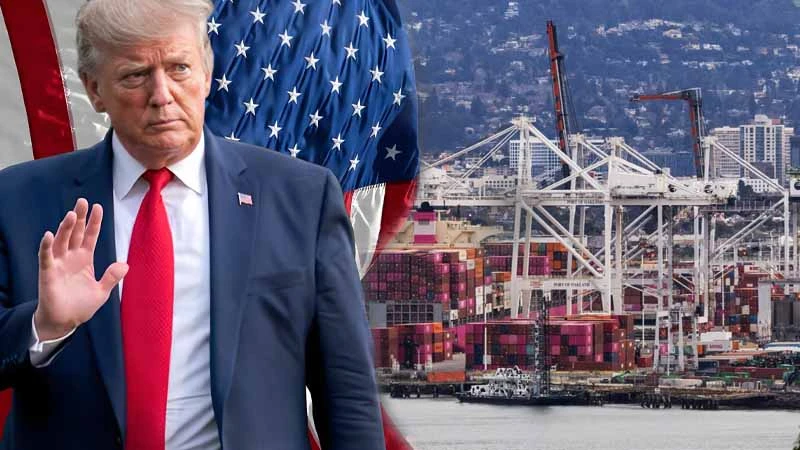Trump’s Tariff Policy Triggers Global Trade Tensions: The Logic and Risks Behind the US Dollar Index Surge
After the 2024 US presidential election, the Trump administration’s “Tariff 2.0” policy continued to escalate, from imposing additional tariffs on China, Canada, and Mexico to establishing a “Foreign Tax Bureau” to strengthen trade barriers, causing severe disruptions in global supply chains and currency markets. Against this backdrop, the US Dollar Index surged past the 107 level, reaching a near two-year high. This strong dollar trend not only reflects market demand for safe-haven assets but also reveals the policy logic and risks behind the so-called “Trump Trade“. This article will analyze, from three perspectives, the driving forces behind the rise of the US Dollar Index, the chain effects of trade conflicts, and the key variables for future markets.
How Tariff Policies Became the “Catalyst” for the US Dollar Index
Trump’s trade protectionist policy is essentially to force industries to return to the US through raising import costs, but its side effect has unexpectedly boosted the dollar’s safe-haven status. The formation of this phenomenon can be deconstructed through the following two mechanisms:
The “Tariff-Inflation-Interest Rate” Spiral Effect
According to analysis by Goldman Sachs research team, Trump’s imposition of a 10% baseline tariff on all imported goods (with some Chinese products taxed as high as 60%) will directly push up domestic production costs and consumer prices in the US, forcing the Federal Reserve to maintain high interest rate policies longer to curb inflation. This move, on one hand, attracts international capital inflows into dollar assets, and on the other hand, compresses the monetary policy space of other economies, creating a dollar interest rate differential advantage. For example, in January 2025, the yield on the US 10-year Treasury rose to 4.5%, while the European Central Bank cut rates during the same period to stimulate the economy, further increasing the dollar’s attractiveness.
The “Domino Effect” of Currency Depreciation
In response to tariff shocks, export-oriented economies such as the eurozone and Japan were forced to maintain competitiveness through currency depreciation. Taking the yen as an example, after November 2024 its exchange rate against the dollar plummeted from 139 to 156, a drop of more than 9%. Such a “devaluation race” objectively strengthened the relative value of the dollar, forming a vicious cycle of “US raises tariffs, other countries devalue, dollar strengthens”.
The “Triple Shock” of Global Trade Tensions
Tariff policies are not merely a monetary phenomenon but have profound impacts on the real economy. Current trade conflicts have expanded from unilateral sanctions to systemic risks, mainly reflected in the following aspects:
Cost Transfer of Supply Chain Restructuring
Trump’s additional tariffs on key industries such as steel, aluminum, and electronic products have forced multinational companies to relocate production bases. For example, Chinese exporters, in order to avoid the 60% tariff, have had to shift production capacity to Southeast Asia. However, logistics disruptions and technical adjustments during the relocation process have instead driven up end-product prices. According to estimates by ING, global supply chain costs in 2025 may increase by 15%-20%, with these costs ultimately borne by consumers.
The “Double Blow” to Resource-Exporting Countries
The combined effect of a strong dollar and tariff barriers has worsened weakness in the commodity market. Taking Canada as an example, its crude oil exports have been restricted by US tariffs, and the Canadian dollar depreciated 3.2% against the US dollar in February 2025 alone, hitting a five-year low. Resource-exporting countries are facing the dual pressure of “declining export volumes + local currency depreciation”, with a significantly increased risk of widening fiscal deficits.
The “Expectation Game” in Financial Markets
Market interpretations of tariff policies are highly divided. In the short term, risk aversion has pushed up the US Dollar Index, but according to analysis by macro-financial research teams, Trump’s tax cut bill faces significant challenges in being renewed, and the scale of fiscal stimulus may fall short of expectations, putting the dollar under potential correction pressure. This uncertainty has intensified volatility in both stock and currency markets. For instance, in February 2025, the Dow Jones Index fluctuated by more than 500 points in a single day due to tariff-related news.
The Future of the US Dollar Index: Can the Strong Cycle Continue?
While dollar strength is currently the main theme, its sustainability depends on three key variables:
The “Marginal Effect” of Tariff Policies
If Trump further expands the scope of tariffs (such as imposing taxes on the European automobile industry), safe-haven demand may continue to support the dollar; conversely, if the policy shifts toward negotiation, the US Dollar Index may fall below 105. Historical experience shows that during the 2018 China-US trade war, the US Dollar Index surged to 96 due to tariff escalations but fell back to 90 after agreements were signed.
The “Policy Flexibility” of the Federal Reserve
The market has currently priced in an expected 25-basis-point rate cut by the Federal Reserve within the year, but if tariffs push inflation beyond expectations, monetary policy may turn hawkish again. According to Goldman Sachs, if the US core PCE Price Index exceeds 3.5%, the Federal Reserve will be forced to resume rate hikes, further strengthening the dollar’s position.
The “Countermeasure Toolbox” of Various Countries
China’s expansion of domestic demand, the EU’s advancement of carbon tariffs, and ASEAN’s acceleration of regional free trade agreements may weaken the actual impact of US tariffs. For example, China’s fiscal deficit ratio in 2025 has risen to 3.8%, using infrastructure investment to ease pressure from export declines. If such policies prove effective, depreciation pressure on the RMB will be reduced, and the upward momentum of the US Dollar Index will also diminish.
Conclusion: Finding Balance Amid Vulnerability
The surge of the US Dollar Index is essentially a reflection of the disorder in global economic governance. For investors, two major risks require caution: first, the “stagflation trap” triggered by tariff policies, and second, the chain reaction of a debt crisis in emerging markets. As Treasury Secretary Connally of the Nixon era once said, “The dollar is our currency, but it’s your problem”. Under the current landscape, diversifying asset allocation, monitoring policy negotiation developments, and positioning in anti-inflation assets will be key strategies to navigate the cycle.
Frequently Asked Questions
Q1. What is the US Dollar Index?
The US Dollar Index (DXY) is a comprehensive indicator that measures the exchange rate changes of the US dollar against a basket of major currencies, reflecting the degree of the dollar’s strength in the international foreign exchange market. Its core features include:
- Constituent currencies and weights: It comprises six currencies: euro (57.6%), Japanese yen (13.6%), British pound (11.9%), Canadian dollar (9.1%), Swedish krona (4.2%), and Swiss franc (3.6%).
- The euro has the highest weight, so the US Dollar Index is highly negatively correlated with the EUR/USD exchange rate.
- Calculation basis: March 1973 is used as the base period, with the base value set at 100, and the index is calculated through a weighted geometric mean of the dollar’s exchange rate changes against these six currencies.
- Core function: It indirectly reflects changes in US export competitiveness and import costs, providing investors with a macro reference for the US dollar exchange rate trend.
Q2. What Does a Rising US Dollar Index Mean?
A rising US Dollar Index indicates that the dollar is appreciating against a basket of currencies. Its impact can be analyzed from the following aspects:
Impact on Global Markets:
- Decline in commodity prices: International commodities (such as crude oil and gold) are mostly priced in dollars, and dollar appreciation puts pressure on their prices.
- Changes in capital flows: Funds tend to flow into dollar assets for safe-haven purposes, which may trigger currency depreciation and capital outflow risks in emerging markets.
- Relative depreciation of other currencies: For example, the euro and yen fall against the dollar, affecting import and export costs in the respective countries.
Impact on the US Economy:
- Decline in export competitiveness: Dollar appreciation makes US goods more expensive in international markets, suppressing export demand.
- Lower import costs: It benefits US companies by allowing them to purchase overseas raw materials or goods at lower costs.
- Stock market volatility: Federal Reserve rate hikes (often accompanied by a strong dollar) may trigger corrections in US stocks while attracting international capital into the US bond market.
Related articles
-
Since 2025, global financial markets have continued to focus on the monetary policy trends of the US Federal Reserve (Fed) and movements in the US Dollar Index. As a barometer of the international market, the performance of the US Dollar Index (DXY) directly affects asset prices and capital flows in...2025 年 3 月 18 日
-
2024 Q4 US Nasdaq Index plunged 3.6%, while the Hang Seng Tech Index fell 4.2% simultaneously, highlighting that the linkage between the two markets has deepened to the level of capital flows. Facing the Federal Reserve’s policy swings, the tech industry’s cyclical shifts, and rising geopolitical risks, Hong Kong stocks...2025 年 2 月 21 日
-
In February 2025, Donald Trump's 25% tariff on imported cars triggered an instant earthquake in the global supply chain. This trade policy, which has been labelled “America First 2.0", has not only forced multinational car companies to urgently reorganise production, it has also pushed the price of precious metals past...2025 年 2 月 21 日













